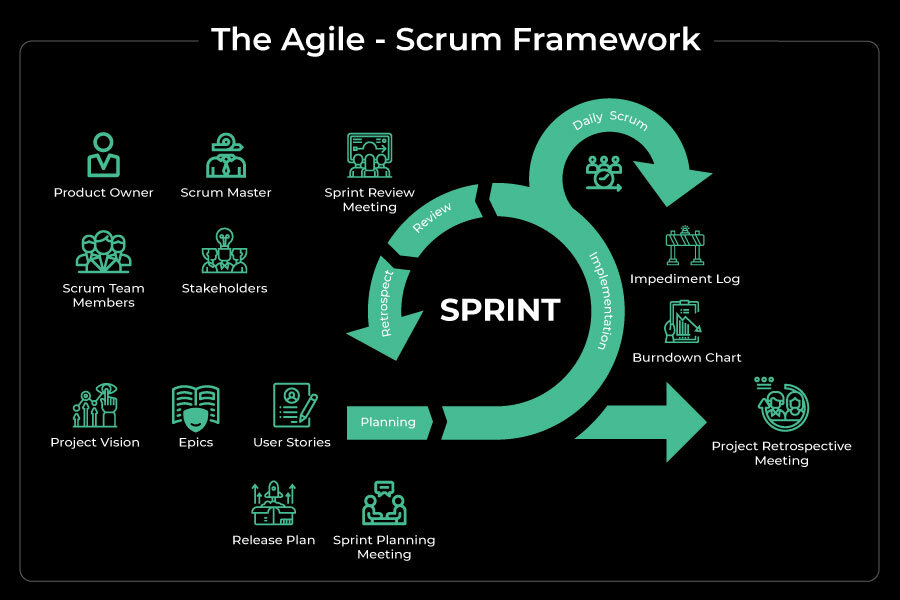Any sort of product-based work cannot happen effectively without updating and productivity. Daily standup meetings, often known as Scrum calls, are an excellent approach for teams to improve their productivity and communication. Scrum is a simple agile project management framework that can be used to create and manage all sorts of iterative and incremental projects. The reasoning is to break down huge, difficult tasks into smaller stages, evaluating and changing as needed. These short meetings take place at the same time and place every day so that team members can discuss their goals and roadblocks while keeping the conversation action-oriented. The daily scrum meeting is designed to assist team members in focusing on common goals. It should also assist students in making a commitment to their goals. The daily scrum meeting is frequently held while the team is standing. The standing portion is crucial. Standing teams are more focused and energetic. An individual who sits down will not have the same feeling of urgency, causing the meeting to drag on longer than it should. Before we get into the details further, let’s have a brief about agile project management as well.
Agile project management
‘Agile‘ is a catch-all phrase that refers to a variety of agile development methodologies, including Scrum. Agile project management is a specific topic in projects. The Agile approach is a project management strategy that breaks down a project into segments. It needs regular communication with stakeholders as well as continuing growth at all levels. Once the project begins, teams go through a cycle of planning, executing, and evaluating. Collaboration between team members and project stakeholders is critical. The scrum team refers to the group of people that are working on the project. A Scrum team is normally small, ranging from three to 10 persons, however bigger (and smaller) teams are occasionally required. Scrum Teams are self-organized and cross-functional, which means they find out how to accomplish their work, manage themselves as they work, and have all of the abilities they need to get the job done. Remember that the Scrum Master’s product and primary aim is a Well-Formed Team.

Scrum Master
Scrum Master is a Scrum framework job that is in charge of ensuring that everyone understands Scrum theory, practices, rules, and values. You’ll communicate with and coach people both inside and outside your Scrum Team as you take on the position of Scrum Master.
The scrum master is expected to function as a coach inside your team, ensuring that your team follows agile ideals and principles. They also serve as a mirror, ensuring that your team adheres to the procedures and methodologies you agreed to adopt. They assist their team in establishing efficient contacts with stakeholders and other teams on the outside. This frequently necessitates coaching stakeholders on how to communicate with the team.
How to boost Scrum calls?
- Maintain the focus of the meetings.
Making ensuring the meeting stays on track is the first step toward an efficient Scrum meeting. To do this, the only subjects that should be covered at this time are the projects that each team member is working on and the issues that they are encountering.
- Keep the meetings brief.
Overly long daily scrums are ineffective. Participants may become sidetracked and this can lead to a lack of attention eventually. As a result, your staff starts to dislike these meetings, and communication breaks down. That is why it is critical to keep your meeting duration to a minimum. People are more inclined to pay attention and deem them vital if they are shorter.
Certain organizations use the formula 2n + 5 minutes, where n is the total number of people on their squad. In any case, following the 3-question rule will ensure that your team gets all of the information they want within the time constraints.
- For unsettled difficulties, use a ‘Parking Lot.’
The goal of daily scrum meetings is to inform team members on what is being done, what remains to be done, and what obstacles are preventing them from being completed. Anything not on this list must be dealt with later. Create a ‘parking lot’ and a list of concerns that will be addressed later. Schedule another meeting with only those members who are directly involved with that problem once the first one is done. You might have a notebook or a whiteboard handy to keep track of subjects that should be addressed by a certain sub-division and require more in-depth discussion. Such ‘parking lots’ should be available to team members outside of daily scrum sessions as well, where they may write down their action items. They will be completely focused and will not be distracted during their daily scrum meetings.
- Remote employees should be included in daily Scrum meetings.
The fact that remote employees aren’t physically there with the rest of the team doesn’t imply they can’t participate in daily Scrum. During the daily stand-up, they can conference call in or, even better, video chat. Of course, there are logistical considerations when organizing this, since you must account for many time zones. Make sure you’re not forcing a team member to attend a Scrum meeting at an inconvenient hour. It’s beneficial for team morale and project progress to keep distant workers participating. By requesting that they call in once a day, you can guarantee that your team is working together and that concerns are being addressed.
- Schedule Scrum Refinement at the Appropriate Time
It’s wise to improve your scrum a little after the midway point of a sprint. The start of the sprint isn’t ideal because this is when work picks up and momentum is established. Because you need time to populate the backlog, you shouldn’t do it in the middle. Your team will be so busy finishing off their responsibilities at the conclusion of the sprint that they won’t have time to groom the backlog. As a result, three-quarters of the way through a sprint (or 60%) is optimum.
These meetings, whether referred to as a daily scrum, daily huddle, morning roll-call, morning meetings, coordination meetings, or our own stand-up meetings, are the order of the day. The team members have a clear and coordinated idea of how much work has been completed and how much work remains by receiving an update on what each team member performed yesterday and what he wants to do today. These meetings also serve as a means of ensuring that all members fulfill their obligations. When a member stands up and declares, “I will do this duty today,” he understands that he must report whether the assignment was completed or not the next day.
